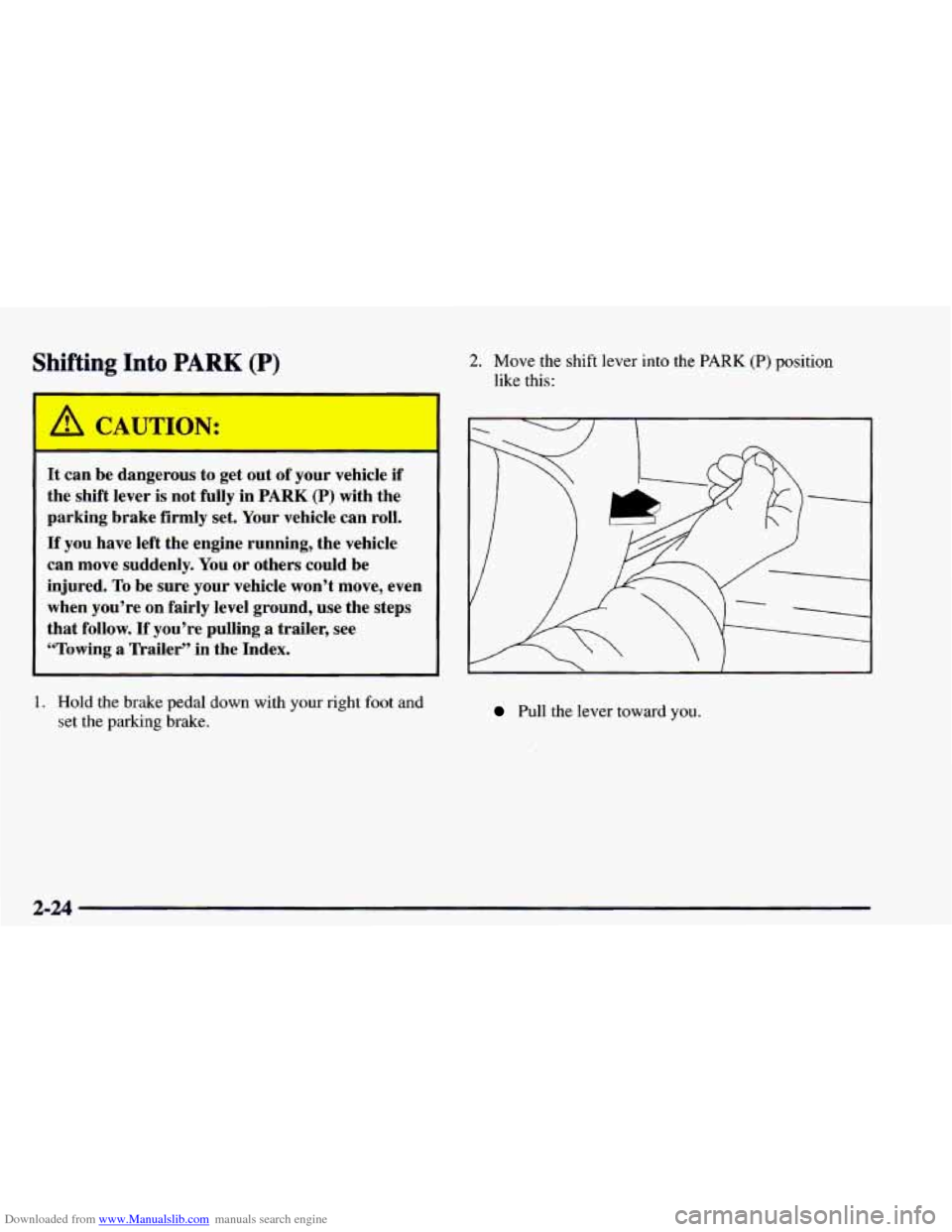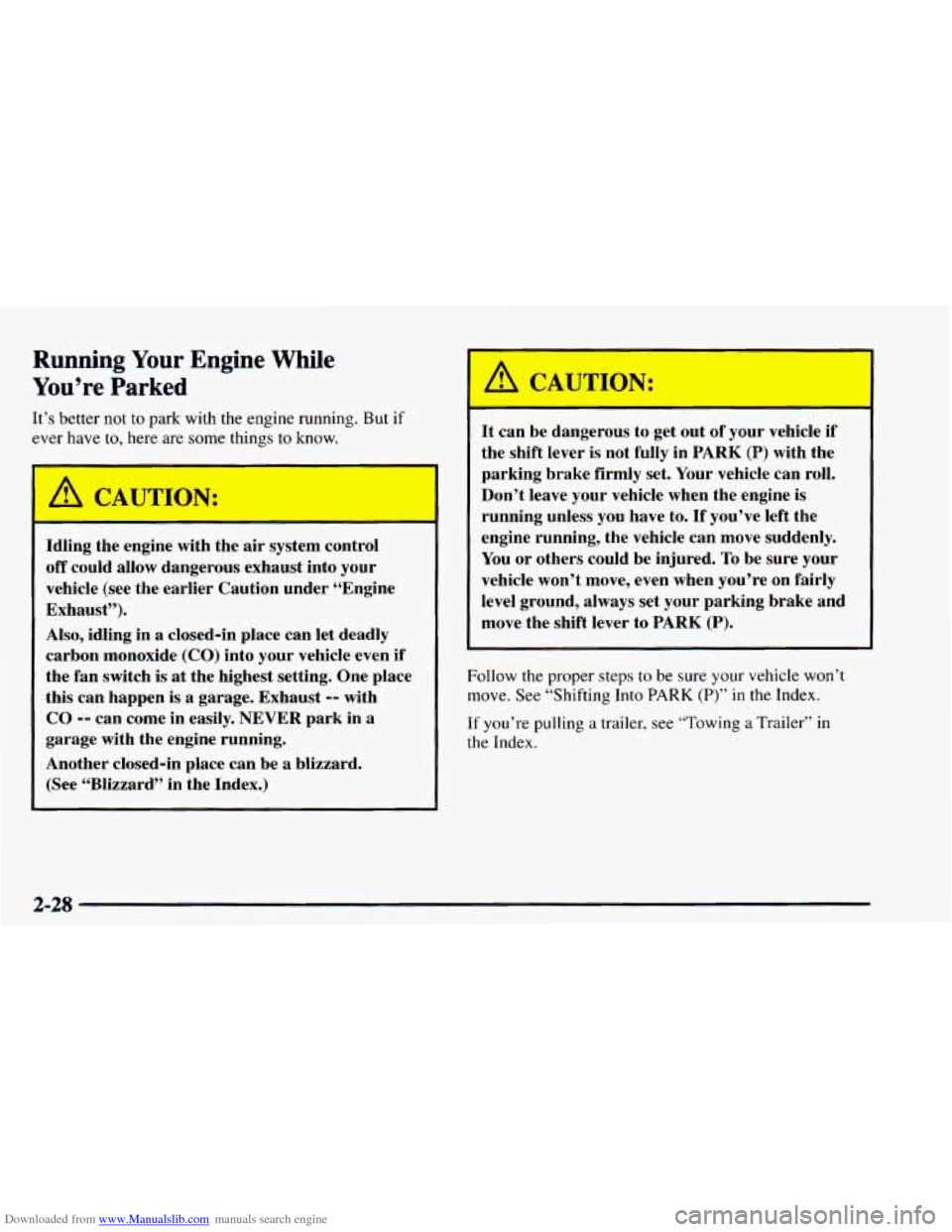1997 CHEVROLET ASTRO towing
[x] Cancel search: towingPage 89 of 404

Downloaded from www.Manualslib.com manuals search engine New Vehicle “Break-In” Ignition Positior- -
NOTICE:
Your
modern vehicle doesn’t need an elaborate
“break-in.” But it will perform better in the long
run if you follow these guidelines:
0
0
0
0
Keep your speed at 55 mph (SS km/h) or
less for the
first 500 miles (SO5 km).
Don’t drive
at any one speed -- fast or
slow
-- for the first 500 miles (SO5 km).
Don’t make full-throttle starts.
Avoid making hard stops for the first
200 miles (322 km) or so. During this time
your new brake linings aren’t yet broken in. Hard stops with new linings can mean
premature wear and earlier replacement.
Follow this breaking-in guideline every
time you get new brake linings.
Don’t tow
a trailer during break-in. See
“Towing
a Trailer’’ in the Index for more
information. Use your ignition
key to
stan your vehicle. The
ignition key lets
you turn the ignition switch to five
different positions.
C
ACCESSORY (A): This position lets you use things
like
the radio and the windshield wipers when the
engine is
off. To get into ACCESSORY, push in the key
and turn
it toward you. Your steering wheel will remain
locked, just as
it was before you inserted the key.
2-15
Page 92 of 404

Downloaded from www.Manualslib.com manuals search engine 3. If your engine still won’t start (or starts but then
stops), wait
15 seconds and start over.
When the engine starts, let go
of the key and the
accelerator pedal.
NOTICE:
Your engine is designed to work with the
electronics in your vehicle.
If you add electrical
parts or accessories, you could change the way
the engine operates. Before adding electrical
equipment, check with your dealer.
If you don’t,
your engine might not perform properly.
If you ever have to have your vehicle towed, see
the part of this manual that tells how to do it
without damaging your vehicle. See “Towing
Your Vehicle” in the Index.
Fuel Regulator
You have a fuel regulator that shuts the fuel off when
the engine reaches 5,600 rpm.
Engine Coolant Heater (Option)
In very cold weather,
0°F (-18°C) or colder,
the engine coolant heater
can help. You’ll get easier
starting and better fuel
economy during engine
warm-up. Usually, the
coolant heater should be
plugged in a minimum
of
four hours prior to starting
your vehicle.
To Use the Coolant Heater
1. Turn off the engine.
2. Open the hood and unwrap the electrical cord.
3. Plug it into a normal, grounded 1 10-volt AC outlet.
2-18
Page 94 of 404

Downloaded from www.Manualslib.com manuals search engine REVERSE (R): Use this gear to back up.
Don’t leave your vehicle when the engine is
running unless you have to.
If you have left the
engine running, the vehicle can move suddenly.
You or others could be injured.
To be sure your
vehicle won’t move, even when you’re on fairly
level ground, always set your parking brake anc
move the shift lever to
PARK (P).
See “Shifting Into PARK (P)” in the Index. If
you’re pulling
a trailer, see “Towing a Trailer”
in the Index.
Ensure the shift lever is
fully in PARK (P)
before starting the engine. Your vehicle has a
brake-transmission shift interlock.
You have to fully
apply your regular brakes before you can shift from
PARK
(P) when the ignition key is in the RUN position.
If you cannot shift out
of PARK (P), ease pressure on
the shift lever
-- push the shift lever all the way into
PARK
(P) as you maintain brake application. Then
move the shift lever into the gear
you wish. See
“Shifting Out of PARK (P)” in this section.
NOTICE:
Shifting to REVERSE (R) while your vehicle is
moving forward could damage your
transmission. Shift to
REVERSE (R) only after
your vehicle is stopped.
To rock your vehicle back and forth to get out of snow,
ice or sand without damaging your transmission, see
“Stuck: In Sand, Mud, Ice or Snow” in the Index.
2-20
Page 95 of 404

Downloaded from www.Manualslib.com manuals search engine NEUTRAL (N): In this position, your engine doesn’t
connect with the wheels.
To restart when you’re
already moving,
use NEUTRAL (N) only. Also, use
NEUTRAL (N) when your vehicle is being towed.
I
Shifting out of PARK (P) or NEU’I AL (N) while
your engine is “racing” (running at high speed)
is
dangerous. Unless your foot is firmly on the
brake pedal, your vehicle could move very
rapidly.
You could lose control and hit people or
objects. Don’t shift out of PARK (P) or
NEUTRAL
(N) while your engine is racing.
NOTICE:
Damage to your transmission caused by shifting
out of PARK (P) or NEUTRAL
(N) with the
engine racing isn’t covered by your warranty. DRIVE
(D):
This position is for normal driving. If you
need more power for passing, and you’re:
0 Going less than about 35 mph (56 kmk), push your
accelerator pedal about halfway down.
0 Going about 35 mph (56 kdh) or more, push the
accelerator pedal all the way down. You’ll shift
down
to the next gear and have more power.
DRIVE
(D) should be used for normal towing.
THIRD (3): This position is also used for normal
driving, however
it offers more power and lower fuel
economy than DRIVE (D).
You should use THIRD (3)
when carrying a heavy load or driving on steep hills.
SECOND (2): This position gives you more power but
lower
fuel economy. You can use SECOND (2) on hills.
It can help control your speed as
you go down steep
mountain roads, but then
you would also want to use
your brakes
off and on.
If you manually select SECOND
(2), the transmission
will drive in second gear.
You may use this feature
for reducing torque to the rear wheels when you are
trying
to start your vehicle from a stop on slippery
road surfaces.
2-21
Page 97 of 404

Downloaded from www.Manualslib.com manuals search engine Parking Brake
To set the parking brake, hold the regular brake pedal
down with your right foot.
Push down the parking brake pedal with your left foot.
If the ignition is
on, the brake system warning light will
come
on.
To release the parking brake, hold the regular brake
pedal down. Pull the brake release lever located on the
lower
left side of the steering column.
I NOTICE:
Driving with the parking brake on can cause
your rear brakes to overheat. You may have to
replace them, and you could also damage other
parts
of your vehicle.
If you are towing a trailer and are parking on any hill,
see “Towing a Trailer’’ in the Index. That section shows
what
to do first to keep the trailer from moving.
2-23
Page 98 of 404

Downloaded from www.Manualslib.com manuals search engine Shiftir: Into PARK (P)
A CAUTION:
It can be dangerous to get out of your vehicle if
the shift lever is not fully in PARK (P) with the
parking brake firmly set. Your vehicle can roll.
If you have left the engine running, the vehicle
can move suddenly. You or others could be
injured.
To be sure your vehicle won’t move, even
when you’re on fairly level ground, use the steps
that follow. If you’re pulling a trailer, see
“Towing
a Trailer” in the Index.
1. Hold the brake pedal down with your right foot and
set the parking brake.
2. Move the shift lever into the PARK (P) position
like this:
1
Pull the lever toward you.
2-24
Page 102 of 404

Downloaded from www.Manualslib.com manuals search engine Running Your Engine While
You’re
Parked
It’s better not to park with the engine running. But if
ever have to, here are some things to know.
Idling the engine with the air system control
off could allow dangerous exhaust into your
vehicle (see the earlier Caution under “Engine
Exhaust”).
Also, idling in
a closed-in place can let deadly
carbon monoxide (CO) into your vehicle even if
the fan switch is at the highest setting. One place this can happen is
a garage. Exhaust -- with
CO -- can come in easily. NEVER park in a
garage with the engine running.
Another closed-in place can be
a blizzard.
(See “Blizzard” in the Index.) It can
be dangerous
to get out of your vehicle if
the shift lever is not fully in
PARK (P) with the
parking brake firmly set. Your vehicle can roll.
Don’t leave your vehicle when the engine is
running unless you have to. If you%e left the
engine running, the vehicle can move suddenly.
You or others could be injured. To be sure your
vehicle won’t move, even when you’re on fairly
level ground, always set your parking brake and
move the shift lever to
PARK (P).
Follow the proper steps to be sure your vehicle won’t
move. See “Shifting Into
PARK (P)” in the Index.
If you’re pulling a trailer, see “Towing a Trailer” in
the Index.
2-28
Page 106 of 404

Downloaded from www.Manualslib.com manuals search engine mrn and Lane Change Signals
The turn signal has two upward (for right) and two
downward (for left) positions. These positions allow
you to signal a turn or a lane change.
To signal a turn, move the lever all the way up or
down. When the turn is finished, the lever will
return automatically.
An arrow on the instrument
panel will flash
in the
direction of the turn or
lane change.
To signal a lane change, just raise or lower the lever
until the arrow starts to flash. Hold it there until you
complete your lane change. The lever will return by
itself when
you release it.
As you signal a turn or a lane change, if the arrows
don’t flash but just stay on, a signal bulb may be
burned
out and other drivers won’t see your turn signal. If
a bulb is burned out, replace it to help avoid an
accident.
If the arrows don’t go on at all when you
signal a turn, check the fuse (see “Fuses and Circuit
Breakers”
in the Index) and for burned-out bulbs.
If
you have a trailer towing option with added wiring
for the trailer lamps, a different turn signal flasher is
used. With this flasher installed, the signal indicator
will flash even if a turn signal bulb is burned out. Check
the front and rear turn signal lamps regularly to make
sure
they are working.
Headlamp High/Low Beam Changer
To change the headlamps from low beam to high or high
to low, pull the multifunction lever all the way toward
you. Then release
it.
When the high beams are
on, this indicator light on
the instrument panel also
will be on.
2-32